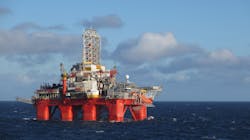Drilling contractors rapidly moving toward hybrid-power, low-emissions rigs
Several global offshore drilling contractors have announced plans to lower CO2 and NOx emissions from their rigs by employing systems that reduce their fuel consumption and increase their fuel efficiency. By and large, they are doing this by deploying a range of new hybrid power systems and battery technologies on their rigs that enable them to lower their environmental impact. Many of these efforts are being supported by the NOx Fund, a Norwegian industry arrangement dedicated to reducing NOx emissions.
In October, Transocean deployed what it claimed is the world’s first hybrid energy storage system aboard a floating drilling unit. The system is now operational on the semisubmersible Transocean Spitsbergen, which is drilling at the Equinor-operated Snorre field offshore Norway.
Transocean’s patented hybrid power technology, developed in partnership with Aspin Kemp and Associates, is said to reduce fuel consumption and increase a dynamically positioned rig’s station-keeping reliability by capturing energy generated during normal rig operations that would otherwise be wasted, and storing it in batteries. This energy is then used to power the rig’s thrusters.
This operational and safety enhancement targets a 14% reduction in fuel use during normal operations, leading to a reduction in NOx and CO2 emissions.
The company’s investment is funded in part through fuel saving incentives in its contract with Equinor and by the Norwegian NOx Fund.
Meanwhile, Northern Drilling’s West Mira is the first rig in operation to be awarded the DNV GL Battery (Power) class notation. The West Mira is an ultra-deepwater semisubmersible that operates a hybrid power plant using Lithium-ion batteries as spinning reserve in dynamic positioning (DP) operations and to supply power during peak load times.
“With the Battery (Power) class notation, we are helping our customers in the offshore industry take advantage of new technologies for safer, more energy-efficient and environmentally friendly operations,” said Geir Fuglerud, Director of Offshore Classification at DNV GL.
“Hybrid and fully electric battery solutions have already been installed in almost 200 marine vessels globally. We are now seeing offshore rigs stepping up to take advantage of these energy storage systems, with several more rigs soon to follow West Mira.”
Installation and testing of the energy storage system have been completed with close cooperation between Seadrill/Northern Drilling, Siemens, Kongsberg Maritime, and DNV GL.
By using the four converter-battery systems, the operator estimates it will be able to reduce the runtime of the rig’s on-platform diesel engines by 42%, cutting CO2 emissions by 15% and NOx emissions by 12%. The system will also serve as back-up to prevent blackout situations and provide power to the thrusters in the unlikely event of loss of all running machinery on affected switchboard segments, DNV GL said.
The Battery class notation applies to Li-on batteries of less than 20 kWh installed onboard DNV GL-classed vessels and offshore rigs. The company said it builds on its rules for the installation and use of Li-on batteries.
DNV GL has also updated its rules for dynamic positioning to include batteries as a “spinning reserve,” a redundant power source for dynamically positioned vessels designed to fulfil IMO equipment class 2 or 3 for vessels with DP systems.
Further evidence of this trend can be found in Maersk Drilling’s plans to convert two of its jackups, Maersk Intrepid and Maersk Integrator, into hybrid, low-emission rigs. This involves running the rig on hybrid power with low levels of NOx emissions, and adding data intelligence to further limit energy consumption and CO2 emissions.
The Maersk Intrepid is an XLE jackup currently contracted to Equinor for operational support on the Martin Linge field development in the Norwegian North Sea. The CJ70 XLE harsh environment jackup Maersk Integrator is currently operating for Aker BP on the Ula field in the southern North Sea.
In recognition of this trend, the International Marine Contractors Association (IMCA) is developing best practices for incorporating new battery technologies into the existing power plants of DP ships. Various IMCA member companies have incorporated hybrid power technologies on DP ships, and the initial feedback is said to be very positive, including economic benefits. •




